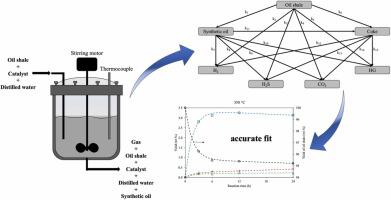The Journal of Supercritical Fluids ( IF 3.4 ) Pub Date : 2024-01-26 , DOI: 10.1016/j.supflu.2024.106193 Guillermo Félix , Richard Djimasbe , Mikhail A. Varfolomeev , Ameen Al-Muntaser , Alexis Tirado , Muneer Suwaid , Konstantin Y. Prochukhan , Andrey S. Bochkov , Konstantin N. Frolov , Oleg V. Zhdaneev , Eduard A. Galiullin , Insaf N. Shamanov , Evgeniya V. Morozova , Bulat I. Gareev , Jorge Ancheyta

|
4- and 7-lump kinetic models for oil shale catalytic upgrading at sub- and supercritical water conditions (300-400 °C of temperature, 1-48 h of reaction time, and 1:1 water-to-oil mass ratio) were developed from experiments conducted in a 300 mL batch reactor. Four catalysts were used based on two transition metals (Ni and Fe) and two ligands (vegetable and tall oil). The use of catalysts with tall oil diminished the secondary cracking reactions to a greater degree than metal-vegetable oil catalysts, producing higher synthetic oil yield and lower gas yield. Temperatures higher than the critical point of water (>400 °C) cause the secondary cracking of synthetic oil molecules, reducing its yield. The best results were obtained using Ni-tall oil catalysts since it improves oil shale conversion and suppresses the over-cracking of synthetic oil. The generation of CO2 (mainly from carbonates in oil shale) was the easier reaction among all gases, thus this gas is produced in higher amount. The estimated kinetic parameters of the kinetic models accurately match the experimental data. The statistical and sensitivity analyses indicate that the obtained reaction rate coefficients were properly optimized and correspond to the optimal values.
中文翻译:

使用镍基和铁基油溶性催化剂在亚临界和超临界水条件下进行油页岩提质的动力学模拟
亚临界水和超临界水条件(温度 300-400 °C, 反应时间 1-48 小时,水油质量比 1:1)下油页岩催化提质的 4 块和 7 块动力学模型由在 300 mL 间歇式反应器中进行的实验开发而成 。使用基于两种过渡金属(Ni和Fe)和两种配体(植物油和妥尔油)的四种催化剂。与金属-植物油催化剂相比,使用妥尔油催化剂在更大程度上减少了二次裂化反应,产生了更高的合成油收率和更低的气体收率。高于水的临界点(>400℃)的温度会引起合成油分子的二次裂解,从而降低其收率。使用镍妥尔油催化剂获得了最佳结果,因为它提高了油页岩转化率并抑制了合成油的过度裂化。CO 2 (主要来自油页岩中的碳酸盐)的生成是所有气体中最容易反应的,因此该气体的产生量较高。动力学模型的估计动力学参数与实验数据精确匹配。统计和敏感性分析表明,所获得的反应速率系数经过适当优化并符合最佳值。











































 京公网安备 11010802027423号
京公网安备 11010802027423号